Hybrid education has taken off in 2021. But what is hybrid education? And why do you need a hybrid classroom for it? How is it already being used at educational, what do teachers and students think of it and how is the technology arranged?
What is a hybrid classroom?
You can provide hybrid education from regular classrooms. But if you want to offer the best possible experience to both the on campus and online students, it is wise to design classrooms optimally for hybrid education.
Education simultaneously in the classroom and online
A typical feature of a hybrid classroom is that a number of students and the instructor(s) are in a physical space and the other students participate online via internet. Before covid-19, there were only a few hybrid classrooms in vocational education and higher education in the Netherlands. By the autumn of 2020, dozens were already in use at institutions, and more are expected to follow in 2021.
The online students can follow the education at home, but it is also possible that a group of students is in a different classroom. The latter case is referred to as a connected classroom.
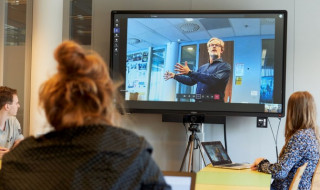
Connected Classroom Inholland
Teaching rooms that are fully equipped for online education are called virtual classrooms. This illustration shows the different types next to each other.
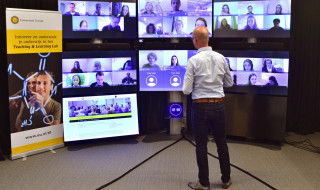
Virtual Classroom Universiteit Utrecht
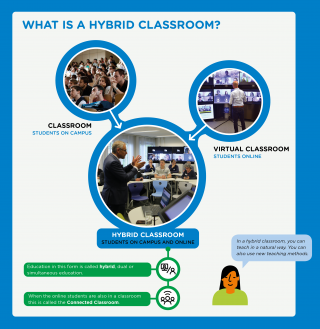
Teaching rooms that are fully equipped for online education are called virtual classrooms. This illustration shows the different types next to each other.
Different names
The name of these new innovative spaces has not yet been decided. A survey of educational institutions in the autumn of 2020 revealed the following:
It went from the oft-mentioned 'ordinary' classroom to 'upgraded' lecture theatre to hybrid classroom, hybrid classroom, hybrid classroom and from connected classrooms, hybrid virtual laboratories, hybrid lecture theatres to hybrid virtual theatre. The descriptions dynamic classroom and global classroom also stood out. The term 'hybrid' was of course often mentioned (17 times) and the term 'blended learning' was mentioned twice.
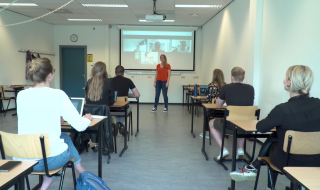
Hybrid Classroom Saxion
Situation hybrid classroom in higher- and vocational education in 2020
In the autumn of 2020, the core team of the Special Interest Group Learning Spaces observed that a number of higher education institutions had come up with quick solutions for using hybrid and virtual classrooms. These often involved "traditional" teaching spaces and "simple" technologies.
To gain insight into these developments, a survey was conducted to find out how institutions were implementing hybrid education in their classrooms. The results have been compiled in a concise publication entitled 'Current status of Hybrid Virtual Classroom'.
Some key points from this survey:
- Before covid-19, only a few rooms had been set up as hybrid/ virtual classrooms in secondary and higher education, such as at Utrecht University and at the KU Leuven.
- We received many responses from Universities and higher education, but also some from vociational education.
- 90% of respondents indicated that they had a hybrid classroom. What was striking was that half the institutions did not just have one room but dozens and even hundreds!
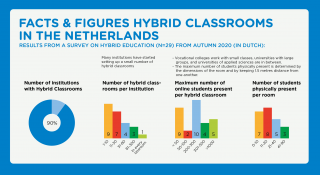
What educational activities take place in a hybrid classroom?
This was a central question during the previously mentioned survey on hybrid classrooms in autumn 2020, but also during a webinar with teachers in October 2020 (Both in Dutch).
The most important educational activities that take place in the hybrid classroom are
- lectures: 75%
- working groups with lecturer: 75%
- discussion sessions: 42%
In the survey, each institution often mentioned these 3 activities at the same time.
In addition, the following was also indicated:
- group work without lecturer: 24
- skills education: 24
What does the hybrid classroom offer?
Apart from the teaching activities, we were also curious about what the hybrid classroom offered for the students who participated online. The main functions that the hybrid classroom supports for online participants are:
- Following the learning activity on site: 97%
- Asking questions to the teacher: 97%
- Working in break-out groups: 85%
- Interacting with students on location: 79%
It is good to see that break-out groups are already being used extensively to allow students to discuss with each other, and that this contributes to social bonding at a time when they can hardly meet physically.
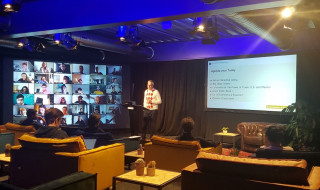
Hybrid Learning Theatre Universiteit van Amsterdam
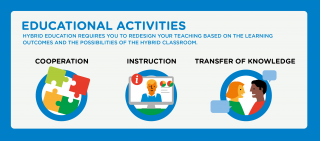
Developing and implementing the hybrid classroom
Read on these pages how to develop and implement the hybrid classroom in your education:
